- Visit the Imagineering Graveyard
- Now Sailing: "Skipper Stories" - Tales from the Jungle Cruise
- Coming Soon: The biography of Disney animator Jack Hannah
- Coming Soon: A Haunted Mansion anthology
The Accidental Mouseketeer
Before and After the Mickey Mouse Club
by Lonnie Burr | Release Date: February 22, 2014 | Availability: Print, Kindle
The Ears Don't Come Off: A Mouseketeer Story
Lonnie Burr never wanted to be a Mouseketeer. When Disney offered him the ears, he turned them down. He was already an established child star, and he didn't want to take a chance on some oddball project involving "Mouseketeers". The next day Lonnie's mom got a call from Disney: "If you don't accept our offer, your son will never work in this town again." Lonnie took the offer. He became famous, his face on magazine covers, the idol of millions of fans, across the world.
And then, in 1959, it was over. What does a Mouseketeer do when the Clubhouse closes?
Lonnie Goes to Hollywood
Long before Walt Disney drafted Lonnie into the ranks of the original Mouseketeers, he was starring in films and television shows as a child actor. He appeared on The Colgate Comedy Hour, and had a recurring role on one of the first "sitcoms", The Ruggles, now lost except for a few episodes and clips. (Lonnie costarred on that show with Margaret Kerry, the live model for Tinker Bell.)
The Mickey Mouse Club changed everything. Lonnie and the other Mouseketeers became national stars. But behind the scenes, politics and jealousy and young hormones ruled the clubhouse, along with the growing realization that the fortune Disney made from the show and from merchandising its stars was not trickling down to the Mouseketeers themselves. When Disney took The Mickey Mouse Club off the air in 1959, none of the Mouseketeers except for Annette would ever achieve such fame again - but in Lonnie's case, his life had just begun, and what a life he led.
The Accidental Mouseketeer Moves On
With his ears off, Lonnie has scores of stories to tell about his film roles, his television and stage appearances, his sexual relationships, and topics ranging from existentialism to Disney choreography. He describes in uncompromising detail his appearances with other Mouseketeers at Disney events, and how those events never seemed to come off as planned.
Lonnie's stories include:
- His sweet, 1950s romance with Annette Funicello
- Backstage and on the road with other Mouseketeers
- A cross-country publicity trip with Mickey Mouse on Amtrak
- Shooting a film with Elvis—was the King cool?
- Working with Steven Spielberg and David Merrick
- Remembrances of Mouseketeers past (and passed on)
Plus over 100 exclusive photos!
The Accidental Mouseketeer is both tribute and tell-all. Lonnie was a Mouseketeer for only a shrot time, but he never really took off his ears, and behind all of his stories, behind all of the success he found on his own, there's still the little kid, singing and dancing in black-and-white, in front of a generation of Americans who wanted to be just like him.
Table of Contents
Chapter 1: Under the Dining Room Table
Chapter 2: Baby Lon in Babylon
Chapter 3: The Charles Dickens School of Dance
Chapter 4: Judy Garland, Natalie Wood, Melanie Griffith, and Me
Chapter 5: The Teeniest Existenialist
Chapter 6: Spoiled Bling Bling Rotten
Chapter 7: A Mickey Mouse Offer I Could Not Refuse
Chapter 8: No Matrix for Matriculation
Chapter 9: The Rest Was Almost Silence
Chapter 10: Showbizaphobia
Chapter 11: Chilling Draft and Snake Eyes in Vegas
Chapter 12: On the Road (Or, Not a Kerouac in Sight)
Chapter 13: Sour Apples Are Worse Than Sour Grapes
Chapter 14: Some Tough Guys Dance a Little
Chapter 15: Renascence Mouseketeers, or the Middle Ages
Chapter 16: Such Women Do Not Exist
Chapter 17: The Desperate Silence of Testosterone
Chapter 18: Back Home, Candide Weeds His Garden
Chapter 19: Through the Years We'll All Be Friends, Wherever We May Be
Lonnie Burr
Lonnie Burr was an original Mouseketeer, one of four males of thirty-nine Mouseketeers appearing in every season of the original Mickey Mouse Club from 1955-1959.
Before he became a Mouseketeer, Lonnie was a professional child actor/dancer/singer, with appearances on such shows and films as The Colgate Comedy Hour; in a recurring role on The Ruggles, an early situation comedy that helped move all TV programs to Los Angeles; The Greatest Show on Earth; Hans Christian Andersen; and many more.
After The Mickey Mouse Club, Lonnie acquired a B.A. and an M.A. in Theatre Arts by the age of 20, then resumed his career in show business, where he enjoyed continued success, adding choreography, directing, and writing for various media to his accomplishments. He is a published author of poetry, plays, books, his own column, film and theatre critcism, and other pieces for newspapers and magazines. He later worked toward his Ph.D. in English Literature.
Lonnie has appeared in 25 films with such stars as Elvis, Dustin Hoffman, Jimmy Stewart, Billy Crystal, Robin Williams, and Julia Roberts; in 49 plays (Broadway, off-Broadway, and stock); and in over 265 TV shows with Roy Rogers, The Lone Ranger, Angela Lansbury, and Paul Winfield, among many others. He has been directed by Steven Spielberg, Cecil B. De Mille, Bob Fosse, and Gower Champion. His numerous television credits include The Beverly Hillbillies; Hill Street Blues; Murder, She Wrote; and Homicide: Life on the Street.
With his wife, Diane Dickey, Lonnie now lives in Beaverton, Oregon. His first book, Two for the Show, a history of comedy teams and the most comprehensive look at team comedy in print, will be re-released in 2014 by Theme Park Press, in a new edition updated from 2000.
A Chat with Lonnie Burr
If you have a question for Lonnie that you would like to see answered here, please get in touch and let us know what's on your mind.
If you could do it over again, would you want to be a Mouseketeer?
LONNIE: Yes, although I rejected being identified with a kid's show, until I matured enough to realize how many millions of kids and their parents, more than one generation, were in love with the series and could and wanted to return to those memories. Plus, all the kids in about 30 other countries like Russia, Japan, and France.
Without the Mouseketeers, how would your career and your life have been different?
LONNIE: Merely speculation, but I would definitely have pursued my careers as actor/dancer/singer.
Would you have taken other paths?
LONNIE: Probably not, but I have had times when I wished I had gone after two other possibilities: 1) becoming a composer/conductor and 2) working with animals in some way or other.
You've worn lots of hats: actor, dancer, choreographer, playwright, poet, author, director, and others. Who is the essential Lonnie?
LONNIE: "Once a song and dance man, always a song and dance man," is what James Cagney said, winning his only Oscar portraying song-and-dance man George M. Cohan in Yankee Doodle Dandy. The essential Lonnie is a bookish, private fellow who loves nature and disdains parties. One of the few great things about being a child star is that unless you bring it up you retain your privacy. I do not think I could function like a "Kardashian"—nor would I want to; after all, what they do is parade around and be seen, lacking talent, apparently intellect, and other things that I consider the substantive elements of life.
Which actors or directors do you wish you could have worked with?
LONNIE: Having worked for Spielberg and Cecil B. DeMille in films, and Bob Fosse and Gower Champion on Broadway, I would rather not use names and seek the rare director who lets you ply your craft and "mentors" you if you are not achieving what you are attempting to capture, rather than force you to do his or her will. Do that in the editing room. Alec Guinness, Meryl Streep, Daniel Day Lewis, Philip Seymour Hoffman, and the minority of actors who actually "become" characters, rather than the 95% who change clothes, memorize, emote the obvious, and manage to not fall over the furniture, horse, or fire arm as they do those things.
What's the one best and the one worst thing that happened to you during The Mickey Mouse Club?
LONNIE: The best was falling in love and staying in love with Annie [Annette Funicello], who was in love with me, too, the first year of the show, which went beyond shooting to the Disneyland Circus through January 10, 1956. That was swell.
The worst was not being given the opportunity to do other parts of the show and films. I had many more credits in film, radio, TV, commercials, and personal appearances than all 38 of the other Mouseketeers, but for some reason they left me out of narrations; reading for Westward Ho, the Wagons; being on the teen soaps like Spin and Marty; Annette's serial; and so on.
Do you think Disney expected The Mickey Mouse Club to become the cultural lodestone it did? Were they able to capitalize on it, or were they always running to catch up?
LONNIE: Walt could not complete his dream, Disneyland, without an additional $1.5 million dollars. His Disneyland show premiered in 1954 and did well for ABC, so they offered him the needed funds if he came up with a kid-focused, hour-long, five-days-a-week show, which was the MMC. I doubt if they thought it would run in every decade through 2002, give birth to two more shows, be translated into five languages, and play so many foreign markets. It certainly helped them sell closing on a billion sets of EARS. Yes, they capitalized, large C, on it.
What's in your book for the non-Mouseketeer fan?
LONNIE: Why you should never let your child, no matter how talented, become involved PROFESSIONALLY in show biz until they are at least 18. How I have dealt with an almost life-long disease, depression, with a great deal of success. What is the difference between men and women? What is it like to discuss single-malt scotch with Henry Fonda, comedy with Woody Allen, and whatever came up with Elvis, Ginger Rogers, and many more stars that most people have not met.
Do you have any events or appearances scheduled with Disney? Do you foresee any in the future?
LONNIE: None are scheduled, and I have no idea if I will be asked to join the others, or, if so, whether I will. I was treated very badly in 2005 at the Disneyland 50th year anniversary of the MMC at Disneyland, although okay at the 50th anniversary of the Park earlier that year when only four of us were asked to perform. We will just have to see what happens.
Other Books by Lonnie Burr:
In this excerpt, from chapter 2 ("A Mickey Mouse Offer I Could Not Refuse"), Lonnie remembers a fist fight with fellow Mouseketeer Tommy Cole at Disneyland.
My only real buddy during the show was Mouseketeer Tommy Cole. He would stay over at my house and I at his. One time I was taking a bath at his place and he somehow opened the locked door and came in with a bucket of ICE COLD WATER which he threw on me as I pleaded for clemency. His mom, June, who died in early 2008, laughed uproariously in the hall.
This amusing—but not to me then—practical joke was a mini-betrayal that later registered big time as the actual thing after I returned from living in New York and Diane and I became close friends with Tom and his wife Aileen, and their adopted kids Lindsey and Casey, in the ’80s and ’90s. Tommy’s betrayals continued and became too substantive to take ever again, but during the show we were buddies.
Friends in 1955 (and before and after) do argue and I had a very quick tongue, a mandatory defense mechanism that I had developed without malice aforethought at a young age. Being around older guys, having my blond hair and good looks, being intellectual and talented, caused lots of problems.
It particularly offended Darlene, because I inevitably beat her verbally. She had a constant, obsessive need for attention and daily performed her club act, usually starting with her corny Ed Sullivan imitation, which she actually used on one or two of our Mouse segments. She got extremely distressed when she was not the center of attention that she cantankerously demanded. I believe this to be the main reason we did not get along as kids on the series. As an adult her desperate necessity for all eyes present and the limelight continued and seemed to grow so that she became crushed by anyone who was not mesmerized by her patter or singing or anything. When I was forced to be around her, inevitably by Disney appearances, I said little and stayed away as much as possible, but it was always unpleasant. I never want to be in her presence if I can avoid it, and I assiduously have followed that precaution.
Besides, my defensive, aggressive humor was really only kidding, but it was more like a pint-sized Don Rickles than Red Skelton, for I have always had a knack for seeing people’s vulnerabilities, and if they aggressed against me I aggressed right back and enough so that they would think twice before repeating their attack.
Meanwhile, back at the Circus, I was “chopping” Tom, the term then used for brittle, sardonic exchanges—more current versions go, “Yo’ Momma is so…”—in the dressing room, which was a medium-size tent with the boys separated on one side and the girls on the other, and both about thirty feet from the back entrance flap to our much larger one-ring circus tent.
Tommy was getting flummoxed and red in the face so he ordered me to knock it off. I surely had touched on, among other sore points, his pitch pipe. He was mainly a singer and he constantly went around carrying and blowing into a round, plastic pitch pipe, annoying everyone including musicians. It also made a strange bulge in his pants which I frequently referred to: “Is that your pitch pipe, Thomas, or are you just glad to see me?” Stealing from Mae West was not only done by Milton Berle.
Bulges in the pants were a constant threat for boys our age, particularly when we ended a number with our crotches thrust against the girl’s bums, which was far too often. (Somehow, it never seemed to bother Dennis.)
Tommy would compulsively whip out his musical prop and toot away for no reason whatsoever. I did not desist in my jibes and he pushed me. Not being a big fan of the fight game but understanding the gauntlet brandished, I pushed back despite his being older by close to three years and heavier.
We then proceeded to push back and forth for a minute or two: I pushed then he pushed, he pushed then I pushed, and finally Cubby said, “If you guys are going to do that, then why don’t you get out of the dressing room.” Cubby was an assertive little old/young dirty man.
So we exited the tent and then resumed pushing, first him then me or me then him—no fists to the face, we had a show later and a reporter or fan might take a photo—for a few minutes, attracting a couple of the girl Mouseketeers who probably thought we were rehearsing some bizarre dance they had not heard about. One of the ubiquitous mothers looked up from her knitting and said, “You boys shouldn’t be pushing each other out here. What if a fan came by? What would Mr. Disney say? You’re liable to get fired. Go behind the tent if you have to do that sort of thing.”
So we moved to our third venue, behind the tent, attracting more girls and some boy Mouseketeers intent on seeing this innocuous 1955 exercise in limited fisticuffs. We started pushing each other again and probably would have kept at our fevered choreography until lunch, but then Tom accidentally caught me on the chin, which I found unfair. Doreen actually said, “Look, Tommy’s fighting dirty. He hit Lonnie in the FACE!” Dodo has always said things like that.
I impulsively started fighting dirty myself and caught Tom a good one on the ear which knocked him down. I smiled in victory. The sad case was that my mother had been told I was fighting behind the tent and she rushed in and hustled me away from any victorious diatribe as she shouted unpleasant rebukes.
So even if the Mouseketeers were always considered the perfectly behaved children of Disney, at least two of us were capable of having a normal kid’s fight on one occasion over three years. Of course, Tommy recalls it quite differently, with him winning, but the last time it was brought up in a question-and-answer situation in front of an audience in the mid-90s he started his inaccurate version and, at a pause, I commented on mike, “Apparently I hit you harder than I thought.” The audience cracked up loudly. I savored this victory almost as much as the first physical one.
Here are just a few examples of the over 100 photos in the book:
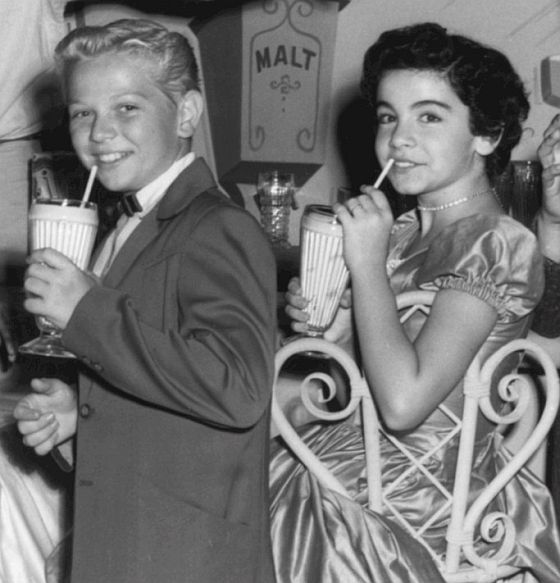
At the Malt Shoppe with my girlfriend, Annette. 1955.
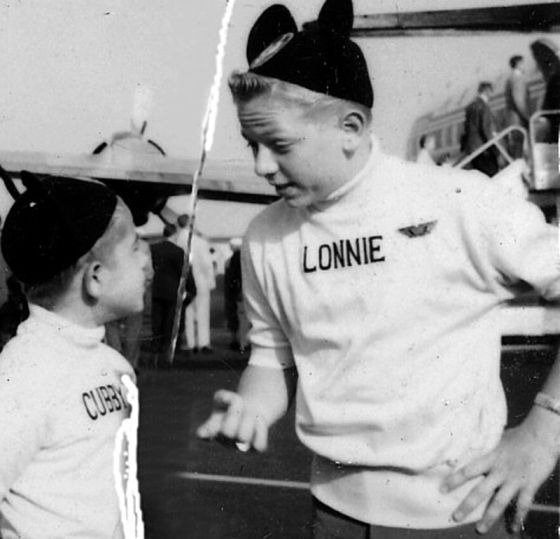
I'm giving Cubby advice in 1956 at the Burbank (Bob Hope) airport before we depart on a personal appearance tour with other Mice.
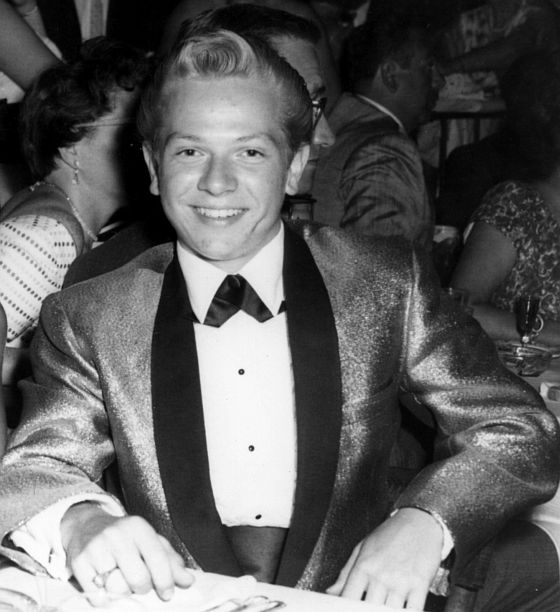
Feeling sophisticated in my gold lamé tuxedo jacket at a grad night event in 1958, a few days after my 15th birthday.
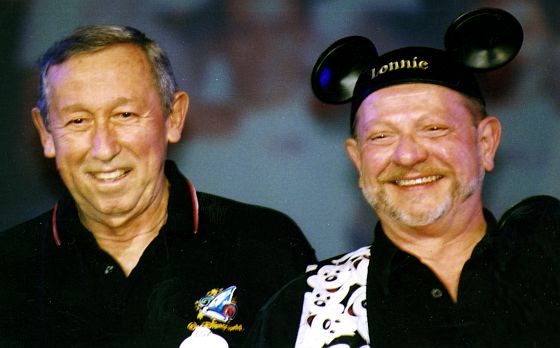
Roy Disney Jr. and a Mouseketeer named Lonnie at 100 Years of Magic at WDW in 2003.

Mouseketeer as author—EARS under hat.
Lonnie Burr and The Accidental Mouseketeer in the news:
Stu's Show
Lonnie appeared February 26, 2014, on the Stu Shostak show to discuss (for nearly three hours!) his book, his life, and questions from the audience.
Fans of Lonnie Burr and The Accidental Mouseketeer will not want to miss:
Lonnie's Website
Lonnie maintains his own website, featuring photos, a scrapbook, and information about Lonnie's DVD set of interviews and film and TV clips of his appearances.
Video Tribute
If you didn't grow up with Lonnie, here's a twenty-minute tribute tape of clips from The Mickey Mouse Club, compiled by a very serious fan:
Tom Snyder Interview
In 1975, journalist and television host Tom Snyder brought Lonnie and several other Mouseketeers on his Tomorrow Show. Stick with it to the end for a surprise, touching appearance from Roy Williams, the "Big Moosketeer", a year before his death:
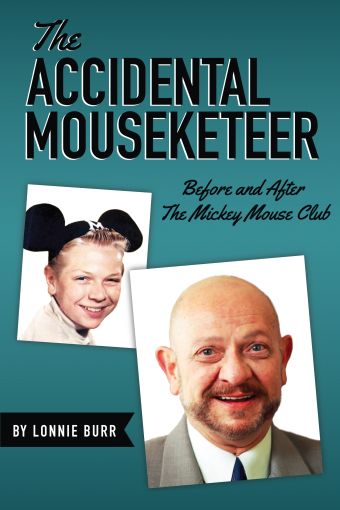
About Theme Park Press
Theme Park Press is the world's leading independent publisher of books about the Disney company, its history, its films and animation, and its theme parks. We make the happiest books on earth!
Our catalog includes guidebooks, memoirs, fiction, popular history, scholarly works, family favorites, and many other titles written by Disney Legends, Disney animators and artists, Mouseketeers, Cast Members, historians, academics, executives, prominent bloggers, and talented first-time authors.
We love chatting about what we do: drop us a line, any time.
Theme Park Press Books
The Unauthorized Story of Walt Disney's Haunted Mansion The Ride Delegate 501 Ways to Make the Most of Your Walt Disney World Vacation The Cotton Candy Road Trip The Wonderful World of Customer Service at Disney Disney Destinies Disney Melodies The Happiest Workplace on Earth Storm over the Bay A Historical Tour of Walt Disney World: Volume 1 Mouse in Transition Mouseketeers Down Under Murder in the Magic Kingdom Walt Disney and the Promise of Progress City Service with Character Son of Faster Cheaper A Tale of Two Resorts I Saw Ariel Do a Keg Stand The Adventures of Young Walt Disney Death in the Tragic Kingdom Two Girls and a Mouse Tale Ears & Bubbles The Easy Guide 2015 Who's the Leader of the Club? Disney's Hollywood Studios Funny Animals Life in the Mouse House The Book of Mouse Disney's Grand Tour The Accidental Mouseketeer The Vault of Walt: Volume 1 The Vault of Walt: Volume 2 The Vault of Walt: Volume 3 Who's Afraid of the Song of the South? Amber Earns Her Ears Ema Earns Her Ears Sara Earns Her Ears Katie Earns Her Ears Brittany Earns Her Ears Walt's People: Volume 1 Walt's People: Volume 2 Walt's People: Volume 13 Walt's People: Volume 14 Walt's People: Volume 15
Write for Theme Park Press
We're always in the market for new authors with great ideas. Or great authors with new ideas. Whichever type of author you are, we'd be happy to discuss your book. Before you contact us, however, please make sure you can answer "yes" to these threshold questions:
Is It Right for Us?
We specialize in books that have some connection to Disney or theme parks. Disney, of course, has become a broad topic, and encompasses not just theme parks and films but comic books, animation, and a big chunk of pop culture. Your book should fit into one (or more) of those broad categories.
Is It Going to Make Money?
There's never a guarantee that any book will make money, but certain types of books are less likely to do so than others. They include: hardcovers, books with color photos, and books that go on forever ("forever" as in 400+ pages). We won't automatically turn down these types of books, but you'll have to be a really good salesman to convince us.
Are You Great to Work With?
Writing books and publishing books should be fun. The last thing you want, and the last thing we want, is a contentious relationship. We work with authors who share our philosophy of no drama and zero attitude, and the desire for a respectful, realistic, mutually beneficial partnership.
If you said "yes" three times, please step inside.
